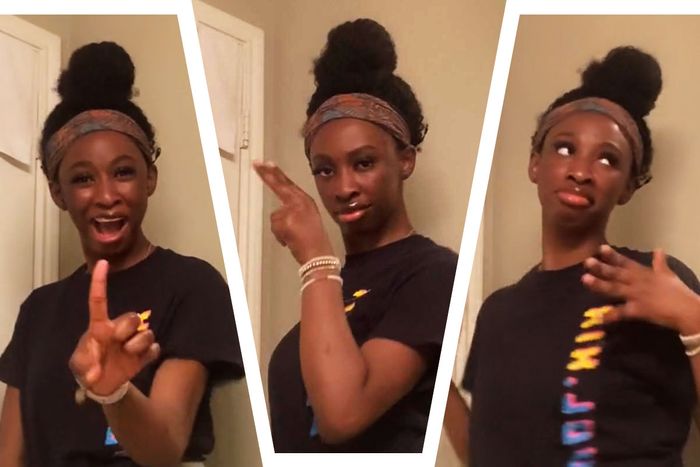
Many of Tracy Joseph’s viral TikToks start with her shaking her index finger at the camera, as if to say, Wait a second. I might be onto something here. Since the 20-year-old often posts her first or second take, when she starts dancing, it’s like she’s reacting to her choreography right alongside her viewers. She often laughs or claps a hand over her mouth after she hits her last move. Then, she’ll post the footage without editing it or even choosing a thumbnail (which means half her feed looks like close-ups of sweatshirts). Her account, @tracy.oj, comes across as a celebration of spontaneous creation. “I just post freely,” she told Vulture during a November video call. “Whenever I want to, whatever I want to, however I want to do it.”
Joseph, currently in the final year of her associate’s degree in nursing at Houston Community College in Texas, started making comedy TikToks in 2019. It didn’t take long for her to grow more interested in dancing on the app. Come 2021, Joseph’s account blew up as her original dances consistently trended throughout the year. She hit 10,000 followers in January; currently, she has 7.2 million. Her dance to Doja Cat’s “Woman” became one of the biggest dance trends on TikTok this year despite being 30 seconds of choreography (unconventionally long for the app). With more than 170.8 million views to date, her video tops 2.4 million other videos set to the Afrobeat anthem. And “Woman” isn’t even her only viral dance off Doja’s Planet Her album — she also popularized moves to “Need to Know” and “Rules.” She has 11 videos pinned in a playlist of her viral dances and 46 videos in a playlist of her dances in general.
Joseph grew up in Edo State, Nigeria, where she says dancing was a culturally significant part of events like weddings, church services, and school gatherings. She moved to Texas when she was around 14 and later briefly joined her high school’s African Student Association to “just vibe and do some African steps” with her peers. These influences are clear in many of her dances, which incorporate what she describes as “basic styles” of Afrobeat dancing. The most prominent example is her choreography to a slowed-down version of CKay’s “Love Nwantiti.”
The moves incorporate the whole body, whereas a typical TikTok tends to focus on the hands. Joseph thinks she can understand the initial wave of criticism she received, with some commenters telling her she shouldn’t have made a dance to the song at all. “The fact that they can’t do it, and it’s something totally different, is what makes their brain hurt,” she surmises. “And be like, Ugh, this is bad. Don’t ever do it again.” Still, that only made her happier when her “Nwantiti” dance eventually did start trending and she saw people attempt it even if they couldn’t master every step. “I really wanna focus more on African styles,” she says. “I think that type of dancing should be put out there. People should really see the beauty of it.”
The process of creating a dance can take Joseph as quickly as half an hour, and it’s never taken her more than one day. First, she picks a sound from whatever the TikTok algorithm puts on her For You page. “If the beat is solid, I’m like, Okay, we’re definitely making a dance,” she explains. From there, her inspiration can come from anywhere. Her “Woman” dance, for example, finishes with a hand motion she first made in a clothing-haul video. Joseph’s overall strategy is fairly simple: She’ll try to include a move that’s trending on the app while also bringing something new to the table.
So far, that formula has produced hit after hit. A career highlight came back on May 30, when Charli D’Amelio, who is currently the most-followed creator on TikTok, did Joseph’s dance to Kayla Nicole’s “Bundles.” Joseph calls D’Amelio “a queen” who has learned from her past mistake of not initially acknowledging “Renegade” dance creator Jalaiah Harmon. So many people had done the “Bundles” dance without giving credit that Joseph decided to create a sound specifically attaching her name to the dance. When D’Amelio did the dance in May, she tagged Joseph and used the new sound. “If Charli can do it, and you didn’t do it, no excuses,” Joseph said during a live stream. “Don’t talk to me.”
During her time on TikTok, Joseph says she’s experienced plenty of so-called “colonizers” taking her work and tagging friends, clothing brands — anyone but her. But the conversation around Black creators on TikTok getting less recognition for their contributions goes beyond credits in captions. She’s also seen how TikTok helped people like D’Amelio and Addison Rae push their careers forward while there was “a different type of vibe” when it came to Black creators. While Joseph never particularly wanted to get verified, she could see that her comments section thought it was unfair that it took so long for her to receive that status symbol. She had more than 6 million followers by the time she finally got her blue check mark in October.
So when she first heard about the Black TikTok strike that came on the heels of Juneteenth this year, she understood the message and the hurt behind it. The idea was that Black creators would show their value by not choreographing dances to Megan Thee Stallion’s single “Thot Shit.” Despite having a hard-hitting beat and a chorus that’s literally about dancing, the song that seemed like prime TikTok audio didn’t turn into a viral dance. But some people extended the strike to any dances in general, and there wasn’t really a consensus on how or when the strike would end. Joseph says she didn’t actually find out about the strike until two weeks after it started. A new dance she’d created to DaBaby’s “Ball If I Want To” was starting to gain traction. “A lot of people were like, That’s good, honey, but we’re on strike,” she recalls.
“It was like, why should I stop creating my content for the sake of the majority?” she questions. “It doesn’t make sense to me because even though you do this, to be honest, it’s not gonna change the fact that there are still gonna be some influencers doing what they’re doing.” She says personally, the strike “didn’t bring any change.” People have continued to do her dances without giving credit, even now that she is no longer a small account. She expects it to the point of no longer getting as bothered or upset when it happens. Joseph also remains unconvinced there’s a long-term creator-led way to prevent this behavior; instead, she’d rather the company focus on acknowledging Black creators to help push their careers forward.
But while she waits for TikTok to catch up, she would like to continue expanding on YouTube (she hears the money there is much better than the TikTok Creator Fund, which she says gives her $8 to $10 for a million views). She’s also been thinking about starting a fashion line of sweatshirts. And she’ll be taking a short break after graduation before heading to the University of Houston’s nursing school in pursuit of her “ultimate goal” of becoming a nurse anesthetist. She still plans to keep making TikTok dances whenever she has time, but she says she doesn’t feel any real sense of pressure around posting.
That’s part of what she’s always liked about this app — and a mentality that’s served her well on it. Two years ago, in November 2019, Joseph made a video with text bubbles of doubts like “You will never be tik tok famous,” “147 followers really??” and “Your dance moves are lame.” In response, Joseph grins at the camera while lip-syncing to Icona Pop. “I don’t care,” she mouths. “I love it.”


